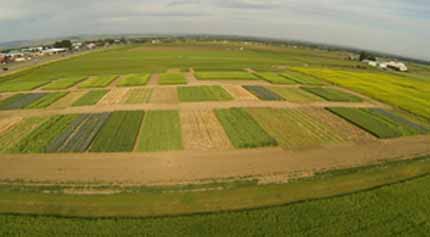Soil Science Society of America
5585 Guilford Road • Madison, WI 53711-5801 • 608-273-8080 • Fax 608-273-2021
www.soils.org
Twitter | Facebook
NEWS RELEASE
Contact: Hanna Jeske, Associate Director of Marketing and Brand Strategy, 608-268-3972, hjeske@sciencesocieties.org
Peas and prosperity
June 1, 2016 - Farmers growing wheat in the relatively arid Northern Plains gamble. They guess how much nitrogen fertilizer to apply to get a high-yield, high-protein harvest. But uncertainties of rainfall and protein content often lead to huge variations in year-to-year income for farmers.
Planting nitrogen-fixing crops, such as peas, in rotation with wheat crops can dramatically reduce this variability, according to recent research by Perry Miller. Miller is an agronomist at Montana State University in Bozeman.
 Nitrogen makes up more than 78% of the earth’s atmosphere. It is key for the building blocks of life, including DNA and proteins. However, major cereal crops, such as corn and wheat, have no way of harnessing atmospheric nitrogen. Instead, they depend on the presence of nitrogen as ammonium or nitrate ions in the soil. To boost levels, farmers apply expensive fertilizers to provide this much-needed nitrogen.
Nitrogen makes up more than 78% of the earth’s atmosphere. It is key for the building blocks of life, including DNA and proteins. However, major cereal crops, such as corn and wheat, have no way of harnessing atmospheric nitrogen. Instead, they depend on the presence of nitrogen as ammonium or nitrate ions in the soil. To boost levels, farmers apply expensive fertilizers to provide this much-needed nitrogen.
Alternatively, legumes such as beans and peas harbor helpful bacteria in root nodules that harness, or “fix,” atmospheric nitrogen. This makes it available to the host plants. “This is a powerful mechanism to build soil organic nitrogen,” says Miller, “and it has been very economical to grow these leguminous crops.”
Crops like peas are at the center of an income strategy for farmers in southwestern Montana. “A cropping system that is more reliant on soil organic nitrogen fixed by legumes and less reliant on expensive bag fertilizer seems to economically stabilize [farm income] in a very important way,” says Miller.
That’s especially true in a system where both the volume and protein content of the harvest have monetary value. The wheat grown in Montana blends to build up the protein content of flour made from wheat grown in other areas. In dry years, when protein content in other wheat crops is relatively high, protein premiums for Montana wheat are low. During wet years, when the protein content of others’ wheat is generally low, the value of Montana wheat increases.
This uncertainty puts farmers in a conundrum, says Miller. “Do farmers hedge their bets and limit the amount of nitrogen they add, because it’s quite expensive, or do they really go for it and gamble?”
Planting nitrogen-fixing crops like peas reduces the economic uncertainty. By relying less on nitrogen fertilizer and more on nitrogen fixed by pea plants, farmers can decrease the year-to-year variability in their incomes.
Cultivating peas in rotation with wheat also has other benefits. Miller’s research shows an increase in soil carbon content, which can benefit crop yields. Also, increasing the diversity of crops decreases weeds and disease.
Miller is now trying to determine the value of this dual-cropping system in the driest parts of the state, in north central Montana. Early results look promising, but the success or failure of dual cropping peas and wheat in these dry areas will likely depend on long-term weather patterns.
In the relatively moist areas of Montana, rotational cropping of wheat and peas is taking hold. “In 2003 there were less than 50,000 acres of peas being grown in the state,” he says, “but in 2015 875,000 acres were grown, and 2016 is projected to be 1.1 million acres.” The nitrogen-fixing peas are becoming an increasingly important crop in the state, and the entire Northern Plains as well.
Read more about Miller’s research in Agronomy Journal.
Miller’s research was funded by USDA Consortium for Agricultural Soils Mitigation of Greenhouse Gases (CASMGS), state USDA-NRCS Conservation Innovation Grant, U.S. Department of Energy Big Sky Regional Carbon Sequestration Project, Montana Wheat and Barley Committee, Montana Fertilizer Advisory Committee, and the Montana Ag Experiment Station.
Agronomy Journal is the flagship journal of the American Society of Agronomy. Articles convey original research in agriculture, natural resources, soil science, crop science, agroclimatology, agronomic modeling, production agriculture, and instrumentation.